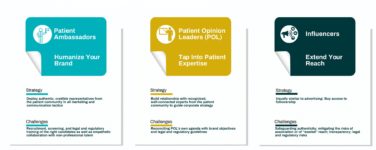2015 will be a year of continuing transition and evolution—but really, that sentiment can be said about every recent year. In 2014, I made a concerted effort to visit agencies all over the world—I wanted to more deeply understand the different regulatory systems and creative processes used by different teams. What I can say with certainty after my travels is what will make 2015 different than other years is the speed and accuracy with which healthcare marketers, companies and brands will be expected to change, test and evolve to stay relevant.
To do so, I offer three keys to success: Understand the new definition of engagement, be agile and quick—yet effective—in offering solutions and commit to creative bravery and risk-taking.
1. The “New” Engagement
For years now, we’ve been hearing about engagement—a two-way conversation between brand and consumer—as a critical means to drive brand growth and loyalty. But in recent years, I’ve noticed engagement beyond this two-way dialogue. Engagement has changed from a two-way conversation to a more comprehensive way of interacting—qualified as active, physical and intellectual.
Active: As we well know, patients are directing their own healthcare journeys—actively engaged in their diagnoses, medication choices and tracking progress. 2014 made more frequent use of terms like patient autonomy, consumerization, patient empowerment, customer-centricity and patient-driven care. Due to the increasingly time- and cost-strapped healthcare systems worldwide, patients need to be more involved in owning their care and successful marketers must continue to develop ways to enhance and enable active engagement.
To me, this speaks most strongly to opportunities in preventative health. On a global scale, preventative health is perhaps the most important movement in healthcare. It’s both medically and financially easier to prevent rather than treat or cure disease, and helps individuals and society as a whole function better. Companies that engage in this mindset, evolving from simply offering treatments, toward providing “beyond the pill” health services that help empower patients to take control of their health will be the leaders of tomorrow.
Physical: On a global scale, patients and professionals are more physically engaged than ever—searching for or consuming health information for hours a day—on mobile devices, in libraries or by speaking to others. It’s the data we can collect passively—data we can aggregate from more advanced technology—that we can glean strong insights from. By analyzing search terms, time of search, and order of search, for example, we’re getting an inside look into a consumer’s mind and thought process.
We’ve known for a long time that it’s hard to get patients to adhere to a treatment plan, and it’s hard to get professionals to fit anything else into their overcrowded workdays. Similarly, focus groups and social listening can only tell us so much. But it’s this unfiltered data that allows a look at how people are physically engaging. If we can develop tools based on these tactile and sensory insights, clients and brands have a strong chance of staying relevant and top-of-mind.
Intellectual: Data and data analysis are intellectually engaging everyone from patients to providers, manufacturers to payers. This is one area where I only see advances and new schools of thought on how to interpret it. We’re all becoming number crunchers, as more data becomes available each day from mobile devices, registries, trackers or clinical settings. Part of what will push these data to meaningful programs will be an increased engagement by physicians, payers and all healthcare players with outcomes data. In the United States, this will be spurred by a 2015 provision of the Affordable Care Act, tying payments to their quality of care.1
We engage with data to make many of the decisions of our lives—from personal ones like what to eat, to professional ones like which treatment algorithm to follow. It’s how we’re using this data—and holding ourselves and our colleagues accountable to understanding and synthesizing these data—that will ensure brands have staying power.
2. Offer Agile and Effective Solutions
While this new definition of engagement offers insight into the ways people, brands, healthcare providers and technology are interacting, it’s how brands and companies react to this engagement that will define their growth in 2015.
Brands and companies that will stand apart are those that build on engagement and interaction and practice agility, built on a deep understanding of their customers and the environment in exquisite detail, along with the ability to innovate and prototype nimbly. Whether it’s a drug-discovery project in the lab, a wearable tracker for patients or a tablet app for providers, any type of healthcare product requires not only the latest technology and the best partners, but—even more important—deft, rapid action.
Thankfully, this action is heavily aided by technology, which is changing not only the way we communicate, but the way we understand and practice healthcare. By way of example, technology is changing drug development in the labs and clinics of both the developed and developing world. Think of the power packed onto microchips, the way a 3D printer can create items seemingly out of thin air, or the increasing complexity of mobile devices. Newer, portable, independently functioning technologies can quickly put bare-bones facilities on a level with cutting-edge labs. Groundbreaking research will increasingly come from outside the traditional centers of excellence. Tech-enabled agility will feature throughout the industry, but perhaps nowhere so strongly as in the lab.
In parallel, marketers will need to learn to navigate and market for a quickly growing class of drugs, as specialty drugs will be an ever-increasing proportion of this R&D. Specialty drugs often treat conditions that are rare or chronic, if not both, and usually can be described with the “three H’s”: High cost, high complexity and high touch.2 The treatments are expensive; require unusual circumstances for their storage or administration; and are accompanied by more monitoring requirements than the average prescription. According to one specialty pharma company, most of the top drugs in the world will soon be specialty drugs.3 The conditions that specialty products address are being diagnosed more often, and the treatments used to address them are proliferating. As big pharma looks to augment pipelines, specialty houses will be appealing targets for partnerships and acquisitions. As a result, many of those unfamiliar with this sector of the industry may find themselves navigating it in 2015—a situation requiring agility if any ever did.
Data agility is another practice healthcare communicators will find themselves practicing in the year ahead. Growing amounts of data are being collected, everywhere you can think of—from the time sales reps spend reading an article on the Internet, to daily prescription adherence and dosage, to where a physician’s eyes track when she reviews the latest peer-reviewed data. It’s fascinating, when it can be analyzed properly. The key to that is to remove the barriers between data sets. For a drug, this could include everything from patient demographics, to prescribing behavior, to pharmacy abandonment, to Phase IV trials. The precision and focus with which the data is attended to can be exquisite, but without agility in combining and re-analyzing the data sets, huge amounts of potentially revolutionary insights are being lost.
3. Enable Innovation
Understanding engagement and ensuring agility and rapid adaptability are critical elements to the final tool healthcare marketers can use to differentiate in 2015—healthcare marketers have to enable innovation by being creative in how we communicate.
In this industry, creativity raises eyebrows: Some will say our heavy regulation kills creativity, but I think fear kills creativity. Creativity matters as much, if not more, in health than in any other industry. Collectively, we must stop thinking that pharma and healthcare people have a different brain than everyone else. All great creative work must have a purpose, it must be meaningful, and it must be relevant to its audiences.
Drawing on the wealth of insight available to us, our industry must continue to push boundaries and encourage experimentation about how to reach the right audience in the right way at the right time. It’s creating this environment—one of creative bravery and innovation—that allows us to push boundaries and take risks. Where risk-taking is unacceptable, innovation can’t succeed.
Many companies pay lip service to innovation, but the successful ones act on it every day. Sometimes, that may mean that something doesn’t work. I believe in encouraging low-risk failure: Setting an example by doing it often; being transparent about both the achievements and the failures; encouraging those who do; and praising those who do it successfully. But having a serious top-down commitment to innovation, and encouraging risk-taking, will be most critical to finding success in 2015—for brands, companies and agencies.
REFERENCES:
1. “Key Features of the Affordable Care Act By Year,” U.S. Department of Health & Human Services. http://1.usa.gov/1g4GGLY.
2. Ringquist, Linda. “What Is a Specialty Pharmacy?” HealthWorks Collective. http://bit.ly/1FQHiNi.
3. “Eight Megatrends Shaping the Future of Specialty Pharma,” SpecialtyPharmaJournal.com. http://bit.ly/1vRuFQM.






